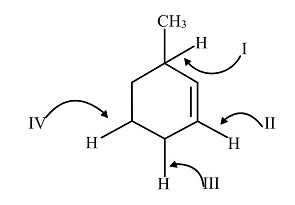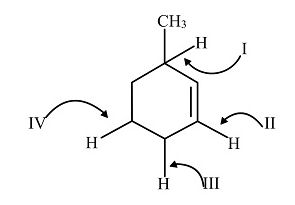
Which C-H bond has minimum bond dissociation energy for homolysis

A. IV
B. III
C. II
D. I

Answer
487.8k+ views
Hint: The bond dissociation energy is defined as the amount of energy required to break the chemical bond formed between the two atoms in a chemical compound. The compound which forms a stable intermediate will be strong and high energy will be required to break the bond.
Complete step by step answer:
The covalent bond present between the two atoms is broken by two ways. It can be done either by heterolytic cleavage or by homolytic cleavage.
In homolytic cleavage, the product formed are radicals and the energy required for breaking the covalent bond is known as bond dissociation energy.
The homolytic bond dissociation energy is defined as the amount of energy required to break one mole of gases which are covalently bonded into radical pairs. The SI unit of bond dissociation energy is kJ/mol.

In the given compound, there are four hydrogen atoms bonded to carbon atoms by a covalent bond. But the C-H bond present at first position forms a stable intermediate by resonance formed by the radical due to the presence of methyl group which shows positive inductive effect, the double bond and the hyperconjugation due to five hydrogen atoms present in the ring.
Therefore, the C-H bond at (I) position requires minimum bond-dissociation energy to break the bond.
So, the correct answer is Option A.
Note: On comparing the primary C-H bond, secondary C-H Bond and tertiary C-H bond, the tertiary C-H bond requires less bond dissociation energy.
Complete step by step answer:
The covalent bond present between the two atoms is broken by two ways. It can be done either by heterolytic cleavage or by homolytic cleavage.
In homolytic cleavage, the product formed are radicals and the energy required for breaking the covalent bond is known as bond dissociation energy.
The homolytic bond dissociation energy is defined as the amount of energy required to break one mole of gases which are covalently bonded into radical pairs. The SI unit of bond dissociation energy is kJ/mol.

In the given compound, there are four hydrogen atoms bonded to carbon atoms by a covalent bond. But the C-H bond present at first position forms a stable intermediate by resonance formed by the radical due to the presence of methyl group which shows positive inductive effect, the double bond and the hyperconjugation due to five hydrogen atoms present in the ring.
Therefore, the C-H bond at (I) position requires minimum bond-dissociation energy to break the bond.
So, the correct answer is Option A.
Note: On comparing the primary C-H bond, secondary C-H Bond and tertiary C-H bond, the tertiary C-H bond requires less bond dissociation energy.
Recently Updated Pages
Master Class 11 Accountancy: Engaging Questions & Answers for Success

Master Class 11 Computer Science: Engaging Questions & Answers for Success

Master Class 11 English: Engaging Questions & Answers for Success

Master Class 11 Social Science: Engaging Questions & Answers for Success

Master Class 11 Economics: Engaging Questions & Answers for Success

Master Class 11 Maths: Engaging Questions & Answers for Success

Trending doubts
Which one is a true fish A Jellyfish B Starfish C Dogfish class 11 biology CBSE

State and prove Bernoullis theorem class 11 physics CBSE

1 ton equals to A 100 kg B 1000 kg C 10 kg D 10000 class 11 physics CBSE

In which part of the body the blood is purified oxygenation class 11 biology CBSE

One Metric ton is equal to kg A 10000 B 1000 C 100 class 11 physics CBSE

Difference Between Prokaryotic Cells and Eukaryotic Cells




